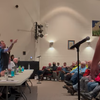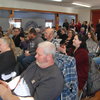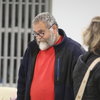School safety researcher urges ‘more love and connectedness’
Enterprise file photo — Noah Zweifel
Berne resident Bonnie Conklin walks through the newly installed metal detector and has her bag inspected before a town board meeting in Berne in 2019. The town board at the time had controversially beefed up security measures following a verbal altercation between two board members.
ALBANY COUNTY — School safety is top of mind for many people, whether they be students, parents, teachers, administrators, or simply empathetic community members who are shaken by too-common headlines announcing another mass shooting.
But, while most everyone agrees that schools should be among the safest places in the country, there’s debate over how that can be accomplished and even about the meaning of safety.
Earlier this month, there were two ultimately non-violent incidents at two different schools in the Capital Region— Berne-Knox-Westerlo High School, in Berne and Voorheesville Middle School, in Voorheesville — that were liable to raise concerns about the potential for a mass shooting incident locally.
At Berne-Knox-Westerlo, a student threatened a peer that he would bring a gun to school and “get you and everyone else.” The threat was determined to be unsubstantiated by the Albany County Sheriff’s Office as the student was not believed to have access to firearms, but he was arrested and charged with making a terroristic threat, a felony; and aggravated harassment, a misdemeanor.
At Voorheesville Middle School, graffiti reading “I have a gun” was found on a bathroom stall and the school initiated a hold-in-place while Albany County sheriff’s deputies probed the building for evidence of a threat. None was found and an investigation was ongoing at the time The Enterprise reported on it (the sheriff’s office did not immediately respond to a request for an update).
To learn more about the ways we think — and should be thinking — about security in schools following incidents like these, The Enterprise spoke with school safety researcher Matthew Cuellar, who holds a doctorate in social work and teaches at the University of Alaska Anchorage.
The student perspective
Notably, Cuellar suggests that however valid fears of mass shootings are, they can overshadow a much more immediate threat to students’ safety.
“I wrote a paper on everyday victimization and the role that school security and school connectedness play in student victimization, and one of the things I really looked at … are these things that we see on the day-to-day,” like bullying and hate crimes and other “incidents that we seem to forget are really common in the public school system,” Cuellar said.
He said that a majority of parents think that a mass shooting in the vein of that at Florida’s Stoneman Douglas High School in 2018, which left 17 people dead and another 17 injured, is the biggest threat to their child’s safety.
“And statistically speaking, that’s certainly a threat,” Cuellar said, noting that it’s something he, too, worries about as a parent. But, in interacting with students, he’s found that, anecdotally, “what really emerges is that students kind of assume that that’s not going to happen in a way that’s very different from parents and other community stakeholders I talked with.”
Instead, students seem more concerned about things like hate crimes, he said.
To that end, Cuellar has been focusing more on the way marginalized students feel about their school environment, since they’re the ones who are at the highest risk for bullying and isolation.
“There’s this climate — particularly for LGBTQ youth, or individuals who break the mold or step away from it — where they’re targeted in ways where they’re not going to get shot, they’re not going to get stabbed, but they’re going to get threatened,” Cuellar said. “And a lot of times, these youths, for whatever reason, are not going to tell someone, whether it’s a fear of being labeled a snitch, or stigma around the issue that’s being discussed.”
The threat of security
Schools across the country have responded and are responding to threats of mass violence by implementing security devices like school resource officers, metal detectors, surveillance cameras, and more — not all of which seem to be effective, and some of which can be harmful to students, especially those who belong to marginalized groups, Cuellar said.
In a study he was part of that examined how school social workers perceive the effectiveness of various safety features, Cuellar and his colleagues referenced a framework devised by other researchers that sorts those features into two categories:
— Authoritarian, which “assumes the use of authority to prevent school violence”; and
— Educational/therapeutic, which “aim[s] to improve school climate by increasing communication between students and school personnel while promoting student connectedness.”
That study found that “practitioners employed in schools serving large percentages of socioeconomically disadvantaged or ethnic minority youth perceive authoritarian strategies as less effective in preventing school violence.”
The authors note that the results are troubling, “as research has demonstrated that larger schools characterized by minority and socioeconomically disadvantaged youth tend to rely on authoritarian strategies.”
While it might be expected that, say, Black students in a district that has a largely white staff might feel victimized by security measures, the same is true of those students even when they’re surrounded by a staff who look like them, Cueller said.
“We still see that African-American students feel targeted, they feel like they’re being watched, they’re reporting that they’re more likely to be searched for contraband than their white or hispanic counterparts,” Cuellar said. “I think this idea of implicit racial bias is really important in how we incorporate security. What biases are in place and what biases are attributable to authority and this authoritarian dynamic?”
Psychological factors
By now, most people are familiar with the term “security theater,” which refers to the appearance of protection for its own sake.
It became embedded in the national psyche after the terrorist attacks on Sept. 11, 2001, which spurred the creation of the Transportation Security Administration, a government agency that’s as jumpy around our shoes as it is over moderate amounts of bath gel — and one that’s supposed vigilance has been shown to be incredibly impotent.
And the term had an offspring during the COVID-19 pandemic in the form of “hygiene theater,” as people wondered (sometimes reasonably and sometimes not) whether various safety protocols made sense given how jumbled they were even after a more stable understanding of the virus had settled in.
It’s not hard to understand why, following tragedies that involve monumental loss of life, rules around different situations change and conversations about those rules become more urgent and emotional. Not only do these measures purportedly save lives, they ease the minds of those who want an absurd world to feel more controllable.
One study that reviewed Americans’ policy stances following the events of 9/11 found that perceived threat of terrorism increased authoritarian tendencies among people who are otherwise more liberal, and another study found that fear can activate those who are more inherently authoritarian.
In 2019, Democrats on the Berne Town Board at the time voted to make meeting attendees walk through a metal detector in response to a loose threat made by Republican Dennis Palow (then a board member, now the town’s supervisor) against Democratic board member Joel Willsey at an earlier board meeting, as well as to have a sheriff’s deputy stationed at the town hall during meetings. That security policy was highly controversial and has since been rolled back.
Whatever the relationship between authoritarianism and fear, it’s not a waste of time to consider, as Cuellar does, how a society that’s increasingly information-saturated responds to bad news.
“Compared to Columbine in the late ’90s, you can get information in a second, and it’s scary,” Cuellar said. “It changes the way we think, and it changes our lives immediately.”
He recalled the day he learned about the Stoneman Douglas shooting; he was standing in line at a hotel in Texas, waiting to check in when the news hit people’s phones.
“Everyone stopped,” Cuellar said. “People got out of line, and even the person behind the register stepped away to take a phone call. Whether we were checking on our kids or looking at the news, it affected us immediately.”
But it’s important to remember the gap that can exist between our feelings about reality and reality itself, and also that immediate reactions can often address our own emotions instead of the problem at hand.
“In regards to the factors that are at play for students and students’ behaviors … I think prevention has to come not from hardening measures, where it’s like, ‘Let me try and find something on you before you come to school.’ It has to come in the form of mental health [awareness and intervention],” Cuellar said.
He added that, at one New Jersey school he studied, the vast majority of his sample had never seen their school’s counselor proactively. They usually had to get in some kind of trouble first, he said.
“There’s this stigma around seeking help and talking to people,” Cuellar explained. “We have to shift our perspective from, ‘These things are available,’ to, ‘How do we increase access to them? How do we address these things in a way that’s not reactionary, like, I got caught with a knife so now I have to go see a counselor?’ It should be, ‘I want to feel safe and comfortable enough at my school that I go see a counselor before I bring that knife.’”
Cuellar says the answer to this problem is unknown and likely complicated, but that “one of the biggest ways we could improve schools is … as crazy as it sounds, make sure there’s more love and connectedness in schools.”



